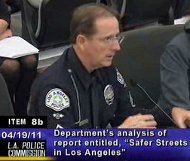4/21/2011
California: Police Officials Narrowly Back Red Light CamerasLos Angeles, California Police Commission split over whether engineering solutions should replace red light cameras.

The Los Angeles, California police commission voted 3-2 on Tuesday to approve a report defending the status quo regarding the use of red light cameras. In January, the city council tasked the commission with reviewing a report by Safer Streets LA that found the department had misrepresented accident statistics to make the program appear effective (view report, 250k PDF). Another report suggested lengthening yellow times one second beyond the bare minimum would reduce violations and accidents (view report, 450k PDF). A third report concluded that 75 percent of tickets were issued for rolling right turns, which have never been a significant cause of accidents in Los Angeles (view report).
The city council wanted to know what changes would improve the existing photo ticketing program. The Los Angeles Police Department (LAPD) joined with the city's transportation department in defending their existing practices and denying the need to make any changes at all.
"What we recommend is what we're doing: a comprehensive, integrated approach," said Commissioner Robert M. Saltzman, summarizing the official response to the Safer Streets challenge.
The written report submitted by LAPD Chief Charlie Beck emphasized that "expert opinion" supports shorter yellow times combined with the use of automated enforcement. Jay Beeber, author of the Safer Streets report, testified that before the city's cameras were installed, the transportation department increased the yellow times at the enforced intersections to meet, and slightly exceed, the legal minimum set out in the California Manual on Uniform Traffic Control Devices. That means the city is unable to say with certainty whether reductions in accidents after camera installation were caused by cameras or the longer yellows.
"If you don't do the engineering first, make those changes, and see what happens, you don't know whether you need a red light camera at that intersection," Beeber said. "Their whole approach is is, we need the cameras anyway. Whatever happens, we need the cameras."
Commissioner Richard E. Drooyan explained that he did not have the expertise required to judge whether longer yellows were called for at an intersection. Dr. Rhodes Rigsby, mayor of the city of Loma Linda, urged the commission to examine the dramatic results he saw first-hand.
"We have experience in Loma Linda with your very situation," Rigsby said. "We had four red light camera controlled intersections and had issued about 30,000 tickets in a four-year period. We actually lengthened the duration of our yellow lights by one second beyond the recommended minimum. You currently have yellow lights that are three-tenths of a second beyond the minimum, and that's commendable... The very day we lengthened the yellow lights by one second, the straight-through violations -- the ones that cause T-bone accidents and kill people -- dropped by 90 percent overnight. The next month [there were] one-tenth as many violations, and it was a persistent change."
The full city council will now have to decide whether to extend the red light camera contract with vendor American Traffic Solutions. A copy of the LAPD response to Safer Streets is available in an 800k PDF file at the source link below.


